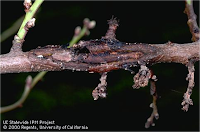Bloom Time Diseases and Control
Almond orchards are usually treated once or more during bloom for prevention of fungal diseases. These diseases include Brown Rot, Jacket Rot, Shot-hole, and Anthracnose. Flowers, flower parts, and young nuts are susceptible to infection, and often serve as the primary point infection for these diseases. Lack of properly timed sprays can provide the opportunity for a large amount of
 |
| Brown rot infection of an almond blossom. The grey "fuzz" is the spores produced by the fungus. |
infections. These epidemics create lingering disease issues which will cause orchard loss for the present and future cropping years.
Brown rot, Monilinia laxa, infects the petals, pistils, and stamens of the almond flower. Upon infection, it moves into the woodier tissues of the tree, killing branches and forming cankers. All varieties are susceptible to brown rot, but they vary in their degree of susceptibility. Butte, Mission, and Wood Colony are the most susceptible; Carmel, Sonora, Fritz, and Monterey are moderately susceptible, while Aldrich, Nonpareil, and Peerless are the least susceptible. Brown Rot Blossom blight is usually controlled with a pink bud and full bloom treatments. Many of UCCE trials indicate that the full bloom treatment is the most important. A third petal fall spray may be necessary in years favorable to disease, especially if bloom is strung out and the weather is wet and rainy. A good rule to follow is that no more than ten days should elapse between treatments in wet weather.
 |
| Canker caused by brown rot within Butte. This canker serves as a resting structure for the fungus. |
A few growers have indicated that they do not spray for brown rot. This may be possible if good conditions persist through bloom AND the varieties planted are not very susceptible to infection (i.e. Nonpareil). It is important to note that not spraying can lead to a serious disease epidemic: a conventional Butte orchard that missed a full bloom spray had over 50% brown rot blossom infection despite no rain! There are many fungicides available for brown rot control, but some recommendations to consider include Benzimidazole (FRAC 1), dicarboximide (FRAC 2), anilinopyrimidine (FRAC 9), DMIs (FRAC 3) and strobilurins (FRAC 11).
The fungi, Botrytis cinerea and Sclerotinia slerotiorum, can infect the jacket of the almond and kill the young fruit as well. This is called Jacket Rot or Green Fruit Rot. Infection occurs from flower opening to petal fall, but consistent rains increases disease. Varieties that are susceptible include Merced, Carmel, Price, Avalon, or any variety with tight clusters. Nonpareil can be affected by this disease if rain and cool weather occur during petal fall. DMI fungicides (FRAC 3) are not recommended for jacket rot prevention as they do not provide effective control of Botrytis.
Shot-hole, Wilsonomyces carpophilus, forms a small circular lesion that eventually falls from the tree, leaving a small hole in the tissue. It can infect leaves, branches, and nuts. If severe enough, it can cause leaf and fruit drop. Overwintering within the leaf buds of the tree, this pathogen is pretty common, and all varieties are susceptible. All fungicides recommended for application during bloom for control of other diseases control shot-hole, thus its appearance within orchards is often minimal even in wet years if properly timed sprays are made.
Anthracnose, Colletotrichum acutatum, is a very aggressive pathogen of almond. Infecting and killing branches and nuts, it reduces yield for multiple years. Anthracnose can be diagnosed by orange to pinkish lesions on young nuts, angular leaf lesions, and nuts that exude gum-balls. Upon infection, the fungus persists within the woodier tissues. This often requires pruning to remove the diseased wood, or several years of an aggressive spray program to clean up the lingering infections. Sprays are effective in controlling the disease, but in rainy conditions, they are needed every 7-10 days in order to prevent infection. DMI (FRAC 3) and Strobilurin (FRAC 11) fungicides are very effective against anthracnose.
